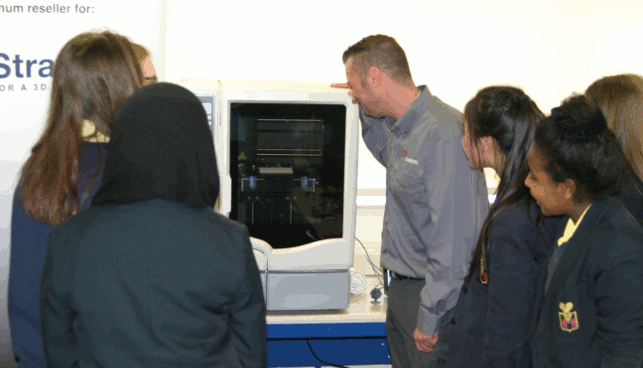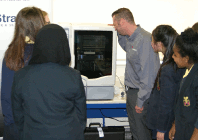A 3D printer can be a powerful machine to have in an educational workshop as long as that workshop also contains other, non-additive, means of manufacturing /fabrication, writes Jeremy Pullin
Recently I have been involved in discussions about setting up a facility aimed at engineering education for non-engineers. The idea in brief is to set up a classroom next to a workshop containing a bunch of kit which can be used to make prototypes, models etc.

Pupils from Watford Grammar School for Girls being shown the difference between a consumer 3D printer and a professional machine during a visit from LaserLines
Amongst the kit planned to go into the workshop are a few desktop 3D printers, which got me thinking about the advantages and disadvantages of 3D printers as educational tools for engineering.
The first thing to consider is what you are trying to teach. If you are getting a bunch of kids to design bodywork for remote controlled cars, whistles or cup holders then it’s a great fit for banging out lumps of plastic in the appropriate shapes required.
If however you are teaching software programming, forging or computational fluid dynamics then it’s no use to you at all. The grey area comes when you start talking about the design of non-customised products, which are going to be produced in their thousands or more.
The biggest advantage that 3D printing brings in this case is the fact that it allows non-engineers to actually make things by lowering the bar to the skills and knowledge required. It’s no exaggeration to say that there are people around who can produce a plastic turbo impeller using a 3D printer but cannot saw in a straight line with a hacksaw.
The importance of being able to actually make things should never be underestimated. This is especially true when you are learning.
A second advantage is the reduction in learning time. The time required to become competent at operating a desktop 3D printer is nothing compared to that which is required to become competent at using the kit you would have had to use if you didn’t have one.
If you are teaching on a finite time budget, this frees up more time to cover other subject areas.
The versatility of a 3D printer is another big advantage. Its ability to produce a myriad of forms means that it takes the place of multiple more specialised pieces of kit. This saves workshop space and means less pieces of kit to buy when setting the workshop up.
Another massive advantage of 3D printing compared with traditional fabrication is safety. There was a time not so long ago when schools did not have technicians to drill holes for the kids using the nasty scary pillar drill thing, the kids did it themselves along with milling, turning, forging, casting etc.
Now of course we live in a compensation culture where personal injury lawyers point the shotguns of blame at the rabbits of employers and educational establishments as they dive for cover behind the grass mounds of health and safety.
Technologies such as 3D printers and laser plotters offer a safe alternative meaning that things can be made despite the ever prevalent health and safety rules and regulations.
Of course as for just about everything in life, there are cons that go with the pros. The most obvious one has to be expense. Desktop machines are easy to get hold of and keep getting cheaper and cheaper but running costs do not come down at the same rate.
While these costs may not be prohibitive, they do not compare well to standard raw materials such as pieces of wood or sheets of plastic.
The next issue is time. 3D printers may well be the fastest solution for things that would otherwise take several stages to produce but when it takes 30 minutes to 3D print a washer (assuming you already have a CAD file and can’t use an off the shelf one) it does not compare well to the 2 minutes that it would have taken you to laser cut it or turn it on a lathe. A print time of a couple of hours is no use to you if you are running a 1 hour class.
Another big disadvantage is the lack of design for manufacture. DFM is crucially important and can make or break the viability of a design as a product. The idea of freeing designers from a world of constraints into a world of endless possibilities where they are limited only by their imagination is one created by the unconscionable and perpetuated by the unknowledgeable.
Although design for 3D printing rules exist, they are different from design rules for more conventional production processes. The danger here is that parts progress from the virtual (i.e. CAD) world to the physical world without encountering the constraints of the processes that will be used to make them if they become non 3D printed products. It’s easy to see how this can ingrain bad design practices into the pupils.
In conclusion, 3D printers are a great thing to have in an educational workshop as long as that workshop also contains other, non-additive, means of manufacturing /fabrication. For educational purposes they should never be used in isolation. The most important lesson (by far) that should be stressed is that just because your design can be 3D printed it doesn’t mean that it is correct for series production.
Jeremy Pullin on setting up a 3D printing workshop for the uninitiated
Default






